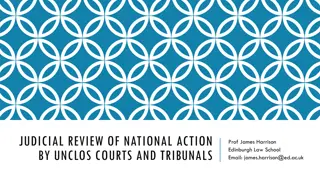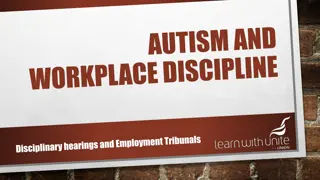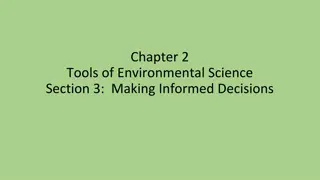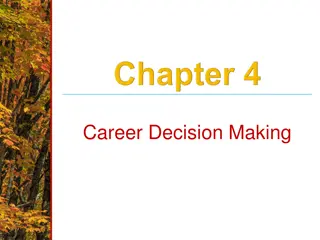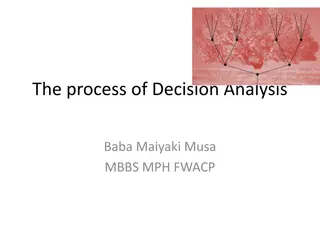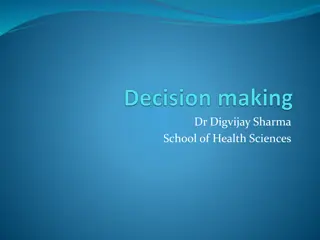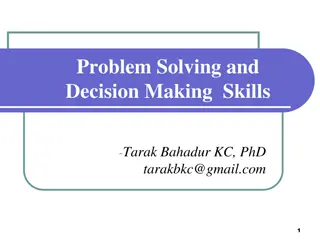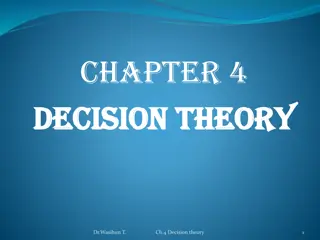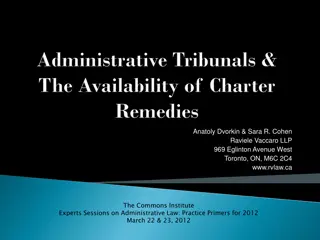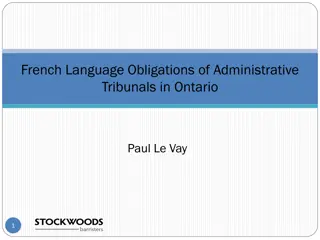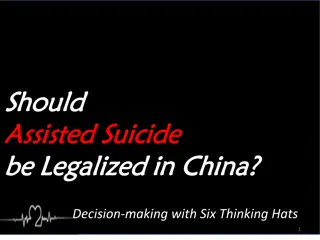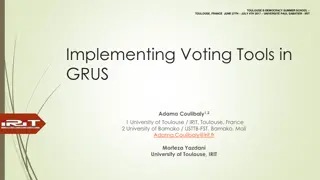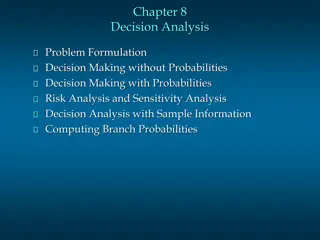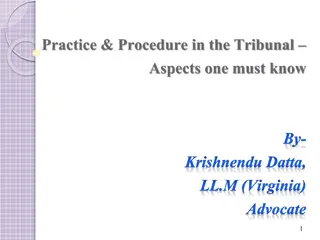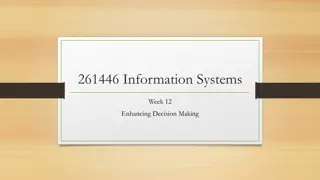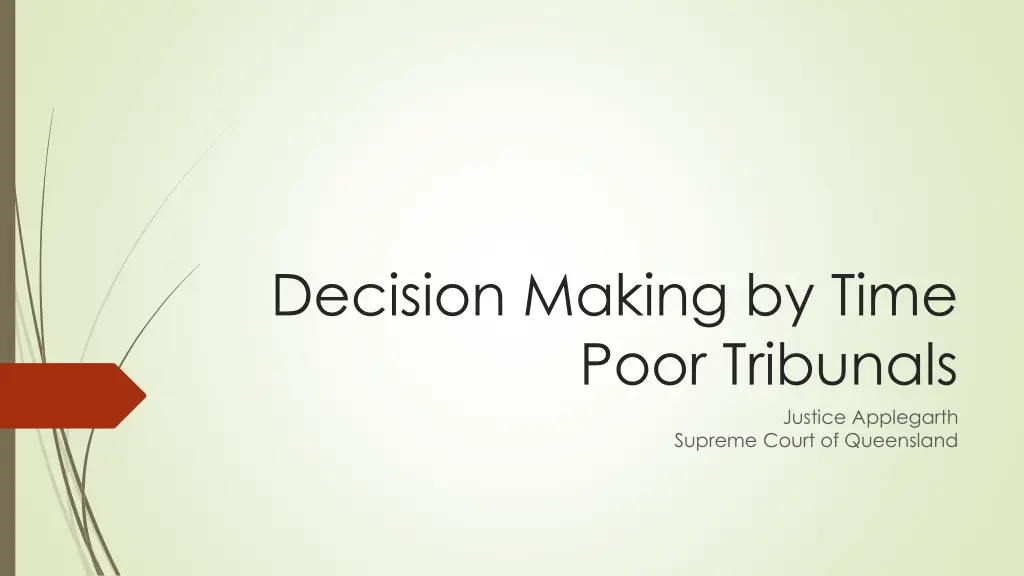
Understanding Cognitive Biases in Decision-Making
Explore the impact of cognitive biases on decision-making processes, with insights from Dr. Donald Redelmeier and research by Tversky and Kahneman. Learn how to improve judgment and avoid common pitfalls.
Download Presentation

Please find below an Image/Link to download the presentation.
The content on the website is provided AS IS for your information and personal use only. It may not be sold, licensed, or shared on other websites without obtaining consent from the author. If you encounter any issues during the download, it is possible that the publisher has removed the file from their server.
You are allowed to download the files provided on this website for personal or commercial use, subject to the condition that they are used lawfully. All files are the property of their respective owners.
The content on the website is provided AS IS for your information and personal use only. It may not be sold, licensed, or shared on other websites without obtaining consent from the author.
E N D
Presentation Transcript
Decision Making by Time Poor Tribunals Justice Applegarth Supreme Court of Queensland
Dr Donald Redelmeier Think the Answer s Clear? Look Again http://www.nytimes.com/2010/08/31/science/31profile.html
Dr Redelmeiers advice: To fellow doctors in the case of the irregular heart rhythm Slow down. Wait just a moment. Check on your thinking. Make sure you are not trying to force the facts into an easy, coherent, but ultimately false story. More generally: You need to be so careful when there is one simple diagnosis that instantly pops into your mind that beautifully explains everything all at once. That s when you need to stop and check your thinking.
Dr D. A Redelmeier Improving patient care. The cognitive psychology of missed diagnoses Abstract: Cognitive psychology is the science that examines how people reason, formulate judgments, and make decisions. This case involves a patient given a diagnosis of pharyngitis, whose ultimate diagnosis of osteomyelitis was missed through a series of cognitive shortcuts. These errors include the availability heuristic (in which people judge likelihood by how easily examples spring to mind), the anchoring heuristic (in which people stick with initial impressions), framing effects (in which people make different decisions depending on how information is presented), blind obedience (in which people stop thinking when confronted with authority), and premature closure (in which several alternatives are not pursued). Rather than trying to completely eliminate cognitive shortcuts (which often serve clinicians well), becoming aware of common errors might lead to sustained improvement in patient care.
Consider This Problem A bat and ball cost $1.10 The bat costs one dollar more than the ball How much does the ball cost?
Judgment under Uncertainty: Heuristics and Biases Biases in judgments reveal some heuristics of thinking under uncertainty Amos Tversky and Daniel Kahneman
Fast & Slow Thinking System 1 (Intuition) System 1 operates automatically and quickly, with little or no effort and no sense of voluntary control. System 2 (Clear/Critical Thinking) System 2 allocates attention to the effortful mental activities that demand it, including complex computations. The operations of System 2 are often associated with the subjective experience of agency, choice, and concentration.
When all is said and done, we must face the fact that judges are human. Jerome Frank, 1949
Linda the Bank Teller Linda is 31 years old, single, outspoken, and very bright. She majored in philosophy. As a student, she was deeply concerned with issues of discrimination and social justice, and also participated in anti-nuclear demonstrations.
Respondents ranked the statement: Linda is a bank teller and is active in the feminist movement. as more likely than Linda is a bank teller.
What is to be done? eliminating all intuition from judicial decision-making is both impossible and undesirable because it is an essential part of how human brains function. Intuition is dangerous not because people rely on it but because they rely on it when it is inappropriate to do so Dr Kylie Burns; Griffith Law Review
Interrupting intuitive thinking based on substitution and stereotypes Cunliffe considers the possibility of a process to interrupt intuitive reasoning that is based on substitution or stereotypes, particularly where the stereotype is otherwise likely to distract the trier of fact from the most likely explanation . This advice to judicial decision-makers is the same basic advice as Dr Redelmeier to the other doctors about the heart arrhythmia case.
Slow Down Slow down. Wait just a moment. Check on your thinking. Make sure you are not trying to force the facts into an easy, coherent, but ultimately false story.
Fact Finding in typical trial courts: for the account that I find more coherent to have occurred, what must the protagonist have done? When and how must she have done it? In what time period did it occur, according to the best and most independent evidence I can muster? How well is this account grounded in the trial record, and to what extent am I making inferences from proven facts? What evidence challenges this account, and do I disbelieve that evidence? Are there things I would expect to see if this narrative were true, but which are absent from or contradicted by the record? And, what assumptions am I making about human behaviour to get to his result? Emma Cunliffe Consider the Opposite Take a Break if you can: Effects of Fatigue, Diminished Resources and Multi- tasking The Israeli Parole Judge problem
Mindfulness (whatever that means) Casey, Burke and Leben in Minding the Court: Enhancing the Decision-making Process suggest: Focusing on the higher purpose of the proceeding, not just on what a busy docket I have today Formalising decision heuristics STOP: Stahl and Elisha Goldstein use the STOP acronym which reminds individuals to: Stop what they are currently doing, Take a deep breath and focus on the sensation of breathing, Observe what they are thinking, feeling, and doing, and Proceed with new awareness. Casey, Burke and Leben say judges can use this quick pause throughout the day, especially when they find themselves getting distracted, bored, or overwhelmed. The pause helps to refocus attention and reaffirm the priority to ensure each case is given a fair process.
Other Techniques Using decision aids Seeking feedback from colleagues Fostering accountability by explaining your decision, ideally in writing, as a means of overcoming intuitive, impressionistic reactions.
Reliance on outside knowledge Whenever we intend to rely on knowledge from outside the record in the case at hand, it is advisable to ask: 1. From where did I get this knowledge? 2. Is it reliable? For instance, is it based on experience which is not reflective of general experience, outdated information or information which is incomplete or contestable? 3. Does fairness dictate that I disclose this knowledge to the parties, and give them an opportunity to make submissions about why I should not rely on it, or give it less weight than I think it deserves.
Engaging with Emotions ..judges should engage with their reactions to emotional stimuli rather than attempt to repress them. Although some judges profess to follow suppression strategies, there is no evidence that such strategies are effective. In general, trying not to think about something not only is ineffective but may even have an ironic rebound effect. Moreover, repression is effortful and cognitively costly, so it may diminish decision making quality. Analyzing and sharing feelings, stepping through a multifactor test or other decision protocol, explaining the basis for decision in a written opinion, or simply allowing the force of affective responses to dissipate with the passage of time, by contrast, can facilitate helpful deliberation. Wistrich, Rachlinski & Guthrie Heart Versus Head: Do Judges Follow the Law or Follow Their Feelings (2015) Texas Law Review 855
Finally, and above all else, follow Dr Redelmeiers advice: Slow down. Wait just a moment. Check on your thinking. Make sure you are not trying to force the facts into an easy, coherent, but ultimately false story.


